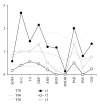The subject, its biology, and the chronic recurrent cystitis
- PMID: 22934220
- PMCID: PMC3420663
- DOI: 10.1155/2012/601705
The subject, its biology, and the chronic recurrent cystitis
Abstract
Functional disorders in urology are troubling for both patients and physicians. Moreover, advances in recent research promise to provide biological insights into psycho-neuro-endocrino-immunological pathways that are one important facet of chronic urogenital inflammations. We present a case of a middle-aged woman with long-lasting recurrent cystitis for which especially a psychosomatic approach helped to understand and cure the disorder. Altogether, as practitioners treat subjects, not illnesses, a biopsychosocial understanding of human disease should be taken into account in cases of chronic recurrent cystitis.
Figures

Similar articles
-
Psychosomatic problems in urology.Calif Med. 1952 Jan;76(1):23-6. Calif Med. 1952. PMID: 14886756 Free PMC article.
-
[Modern aspects of the etiological structure of chronic recurrent cystitis].Urologiia. 2022 Nov;(5):123-126. Urologiia. 2022. PMID: 36382830 Russian.
-
[Psychosomatic aspects of chronic recurrent cystitis].Aktuelle Urol. 2010 Nov;41(6):378-81. doi: 10.1055/s-0030-1262649. Epub 2010 Nov 16. Aktuelle Urol. 2010. PMID: 21082519 German.
-
Cystitis: from urothelial cell biology to clinical applications.Biomed Res Int. 2014;2014:473536. doi: 10.1155/2014/473536. Epub 2014 Apr 30. Biomed Res Int. 2014. PMID: 24877098 Free PMC article. Review.
-
Organ cross-sensitization mechanisms in chronic diseases related to the genitourinary tract.J Smooth Muscle Res. 2021;57(0):49-52. doi: 10.1540/jsmr.57.49. J Smooth Muscle Res. 2021. PMID: 34629366 Free PMC article. Review.
Cited by
-
Caloric vestibular stimulation as a treatment for conversion disorder: a case report and medical hypothesis.Front Psychiatry. 2014 Jun 2;5:63. doi: 10.3389/fpsyt.2014.00063. eCollection 2014. Front Psychiatry. 2014. PMID: 24917828 Free PMC article.
References
-
- Csef H. Somatoform disorders in urology. Urologe A. 1997;36(1):87–99. - PubMed
-
- APA. Diagnostic and Statistic Manual of Mental Disorders. 4th edition. Washington, DC, USA: American Psychiatric Press; 2000.
-
- WHO. ICD 10 International Statistical Classification of Diseases and Related Health Problems: Tenth Revision. WHO; 2005. - PubMed
-
- Schwinges-Lymberopoulos M. Psychosomatic urology: a practice-oriented presentation. Urologe A. 2010;49(6):767–774. - PubMed
-
- Fink P, Schröder A. One single diagnosis, bodily distress syndrome, succeeded to capture 10 diagnostic categories of functional somatic syndromes and somatoform disorders. Journal of Psychosomatic Research. 2010;68(5):415–426. - PubMed
Publication types
LinkOut - more resources
Full Text Sources

